Bishops of the Roman Catholic Diocese of Banská Bystrica
Bishops of the Roman Catholic Diocese of Banská Bystrica in Slovakia.[1][2]
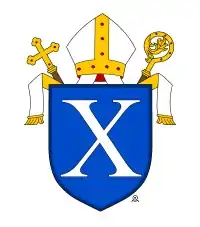


Th Dr. Mons. Marián Chovanec
Marián Chovanec is a Slovak Roman Catholic cleric, and current bishop of the diocese of Banská Bystrica.
Born September 16, 1957, in Trenčín. He studied at the Roman Catholic Theological Faculty in Bratislava and was interned for participating in a hunger strike against state interferences in the church in 1981and expelled from the seminary. He resumed studies in 1986 and in 1990 undertook further studies in the Catholic University in Lublin, Poland. In 1992 he received a licentiate in theology and in 1994 a doctorate in dogmatic theology.
Ordained a priest on June 17, 1989, he worked as a curate Nitra and in 1990 was appointed archivist for the Bishop's office in Nitra and parish administrator Nitra-Dražovce. From 2013 taught at the Theological Institute of St. Francis Xavier in Banská Bystrica-Badin.
On 22 July 1999, he appointed auxiliary bishop of Nitra by Pope John Paul II in the Cathedral of SS. Emeráma. Since August 2000, he has acted as the Secretary General of the Bishops' Conference of Slovakia and from 1 March 2003 to 14 December 2012 he was Vicar General of the Diocese of Nitra.
On November 20, 2012 Pope Benedict XVI appointed him bishop of Banská Bystrica.[3] in the Cathedral of SS. Francis Xavier in Banská Bystrica.[4] He is also titular bishop of Maxita (1999.07.22 – 2012.11.20)
Msgr. Marián Bublinec
(Apostolic Administrator 2011.07.28 – 2012.11.20)
Bishop Rudolf Baláž
(1990.02.14 – 2011.07.27)

Rudolf Balaz was a Roman Catholic bishop of the Diocese of Banská Bystrica.
Born in Nevoľné the youngest of six children. He studied theology at the Roman Catholic Theological Faculty in Bratislava from 1958 to 1963. Refused further education by the communists, he was ordained a priest in 1963 at the hands of Bishop Ambrose Lazik. Between 1968 and 1970 he was an actuary in the bishop's office in Banská Bystrica.
During the Prague Spring (1968) became a member of the Action Committee of the Catholic clergy,[5][6] From 1971 till 1982 was deprived a licence to be a priest by the communist government, but the ban was lifted in 1982 In February 1990, Pope John Paul II named him bishop of the Diocese of Banská Bystrica.[7] He was the first and so far only bishop of the diocese, born in its territory.
From 13 April 1994 to 31 August 2000 he was chairman of the Conference of Slovak Bishops. His last public appearance was the consecration of newly built parish church on Sunday, July 17, 2011 in Horni Ves.[8] At the age of 70 years he died suddenly July 27, 2011 in his episcopal office. he was buried in his home town.
Bishop Jozef Feranec

Jozef Feranec (March 14, 1910, Pobedim – May 3, 2003, Banská Bystrica) was a Slovak Roman Catholic bishop from 1972 to 1990 in the diocese of Banská Bystrica.[9]
He was born on March 14, 1910 in Pobedim. He was a chaplin and teacher till 1970AD.[10]
Pope Paul VI. appointed him bishop for the diocese of Banská Bystrica on 19 February 1973. The diocese had been vacant since 1950AD. In 1973 he became chairman of the Ordinaries of Slovakia. He was an active member of the collaborationist Association of Catholic Clergy Pacem in Terris until its demise after November 1989.[10] He gave his resignation to Pope John Paul II. February 14, Died May 3, 2003 and is buried in his hometown Pobedim.
Bishop Andrej Škrábik
Th Dr. Andrej Škrábik (May 13, 1882, Rajecký – 8 January 1950, Banská Bystrica) was a Roman Catholic priest, bishop, religious writer. Schooled in Žilina and Nitra, he studied philosophy and theology at the University of Budapest and on September 17, 1904 was ordained a priest[11] and in 1911 he earned a doctor of theology. In 1939 he was ordained as a bishop,[11] In 1941 he transferred to the seat of the Bishop of Sv. Cross over Hronom (now Žiar nad Hronom). During the Second World War he used the seminary and the episcopal residence to hide many political exponents. Together with Dr. John Balk is credited with the rescue of ten people. He died 8 January 1950.[12]
Dr. Škrábik was a university professor of theology, the director of religious endowments, judge of the ecclesiastical court, organizer of missionary work. Titular Bishop of Scyrus (1939.08.12 – 1943.08.21) He authored polemical work in defense of the Catholic Church and religion, but also guides the Slovak language for the Hungarians and Contributed to several newspapers and magazines. His works include:
- Škrábik, Úvod do reči slovenskej(intro to Slovakian), (Nitra,1919)
- Škrábik, Ján Hus vo svetle pravdy, (Trnava, 1923)
- Škrábik, Červené slovensko, 1. vyd, (Trnava, 1925)
- Škrábik, Červené slovensko, prepracované 2. vyd, (Trnava, 1926)
- Škrábik, Rímska otázka, (Trnava, 1930)
- Škrábik, Misijným svetom, (Trnava, 1940)
Marián Blaha
Marián Blaha was born Jakub Marian fleas 1869, Liptovský Hrádok, but changed his name in 1915 and was a Slovak Roman Catholic bishop of Banská Bystrica.[13] From 29 June 1893 to 30 October 1895 was chaplain in Nižné Ružbachy then Kežmarok a tutor in the family of Count Andrei Zamoyského the castle in Starej Ľubovni.[14] Between 1913–1919 he was the secretary general of the Society of St. Adalbert in Trnava. After the collapse of the Austro-Hungarian Empire and the creation of Czechoslovakia he was secretly ordained Bishop by Pope Benedict XV[15] He became seriously ill in 1938 and withdrew from office in 1941 and died August 21, 1943 at Holy Cross over Hronom and buried in the crypt of Bishops in Ziar nad Hronom.[15]
Bishop Wolfgang Radnai (later Archbishop)
(1904.07.11 – 1920.12.16)
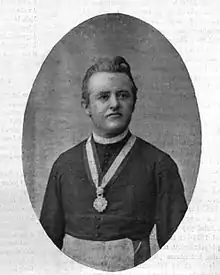
Wolfgang Radnai also known as Radnai Farkas; was born March 25, 1848, Chişinau Romania). In 1871 he changed his surname from the Radnai to Rillhamer.[16] December 1920 appointed titular Archbishop axomiského.[17] After the disintegration of Hungary he was interned for several weeks and on 25 March 1919 the Czechoslovak government held him until his death in 1935.[18] in the summer residence of the Bishop of Veszprém in Sümeg.[16] he died October 14, 1935, Sümeg, Hungary[19]
Karol Rimely
Charles Francis Rimel (4 February 1825 – 13 January 1904), was a Roman Catholic Bishop of Banská Bystrica diocese and church historian.
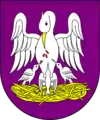 coat of arms
coat of arms.jpg.webp) Károl Rimel
Károl Rimel
Born on February 4, 1825 in Esztergom[20] [1] to the family of Francis and Elizabeth Rimelyho and educated in Esztergom and Bratislava.he studied in Trnava and theology in Vienna, where he taught including Rudolf, Crown Prince of Austria and his two sisters Gizella and Clotilde. In 1870 he was appointed titular abbot of the abbey Lekýr and May 25, 1893 he was appointed Bishop of Banská Bystrica.[21] and was made became a member of the upper Hungarian Chamber of Parliament. He was also Titular Bishop of Europus. His book include:
- He co-authored Magyar Egyetemes Encyklopädie (Uhorská university encyclopedia).
- Rimel, Carolus. Historia Collegii Pazmanian: quam ex tabulariis conscripsit Carolus Rimel .. Viennae: Typis et sumptibus Congregationis Mechitharisticae, 1865.
- Rimel, Carolus. Capitulum insignis Ecclesiae collegiatae Posoniensis the ad. Martini Ep. Olim SS. Salvatore. Posonii: typis Caroli Angermayer, 1880.
He was Awarded Knight's Cross of Leopold Council, 1876 and Cross of the Order of Franz Josef, 1898 He died January 13, 1904, and was buried in the crypt of Bishops in Ziar nad Hronom.[18]
Bishop Imre Bende
Imre Bende (28 August 1824, Baja, Hungary today – March 26, 1911, Nitra) was a religious writer and Roman Catholic bishop of Banská Bystrica and Nitra in 1893 and Bishop of Nitra . A graduate of the University of Vienna he was ordained 1847 he was in the Hungarian Liberal Party.[22] In 1886, he was appointed bishop of Banská Bystrica.[23] He supported Joseph Murgaša during his studies at the Academy of Visual Arts in Munich In Nitra he supported the construction of the girls' higher secondary school. During his time as bishop championed the life of the Church policy of Magyarization.[24] He was the author of several pastoral letters and sermons, contributed to various časpoisov, religious mostly dialogue.
 Bishop Bende
Bishop Bende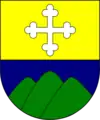 Bende coat of arms
Bende coat of arms
In 1901 received the title of Count of Rome and in 1904 he became an inner secret mentor. In 1910 on account of his age and health relinquished its powers in favor of his auxiliary bishop Viliam Batthyány.
Bishop Arnold Ipolyi-Stummer
Arnold Ipolyi (October 20, 1823, Drženice – December 2, 1886, Oradea) was a Roman Catholic bishop of Banská Bystrica in the years 1871–1886 and 1886 veľkovaradínsky. He was a pioneer in the field of Hungarian art history. Born in a noble family, to Franz Stummer (1799–1848) and Arsenia Smrečaniová (1802–1881) in Kosihy Ipľom and had a brother Louis. His father died in 1848 with the surname Stummer, but his mother's death record in 1881 records her name as Ipolyi-Stummer.
Educated in Krupina and Banská Štiavnica and the Trnava, Vienna, Bratislava and Esztergom, in 1847 ordained a priest. He worked Bratislava, Zohor and others places. He studied folk literature and material culture, and later visual art history and archeology, conservation pioneer artistic heritage and was the author of about 50 publications in which he discussed Hungarian medieval architecture, sculpture, jewelry, emailérstvo and wrote about the history of Bratislava, Trnava, Banská Bystrica, on medieval monuments, prompted the establishment of museums. From 1881 to 1886 president of the Section of the Hungarian Academy of Sciences.
At his request his heart was buried in the Chapel.
 Ipolyi Arnold
Ipolyi Arnold Ipolyi-Stummer CoE
Ipolyi-Stummer CoE
Bishop Zigmund Suppan
(1870.06.27 – 1871) Sigismund Suppan (18 January 1814, Kremnica – July 17, 1881, Esztergom) was a Roman Catholic priest, religious writer, church dignitary, teacher. Born in Kremnica, his father was Sigismund Supan and mother Jana Fogtová. educated in philosophy and theology at Trnava and in 1837 he was ordained a priest.[25] He was an educator, chaplain, director of the cathedral choir, field superintendent, pastor, teacher of Hungarian language and literature, in 1852 director of grammar school in Trnava, and latter a canon. In 1870 he was appointed titular abbot madočského.
In 1870 the Emperor Franz Joseph I appointed him Bishop of Banská Bystrica and Pius IX confirmed the appointment on 27 June 1870.[26] However, he did not accepted episcopal ordination on 16 July 1871 and gave up the episcopal rank.[27] So on 14 October 1871 the Emperor appointed Titular Bishop.[26] Although never ordained in Banská Bystrica diocese, he is listed at 7 of the diocesan bishop.[28] He authored a four-part a textbook of Hungarian language,[29] a brief history of Trnava gymnasium and various homiletic literature. He died July 17, 1881 in Esztergom.
Štefan Moyzes
Bishop Štefan Moyzes (1851.02.17 – 1869.07.05) was Bishop of Banská Bystrica (Slovakia) (1851.02.17 – 1869.07.05) he died: 1869.
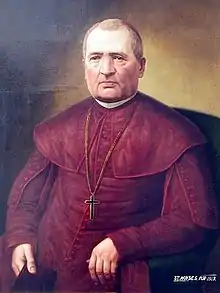 Stefan Moyzes.
Stefan Moyzes. coat of arms
coat of arms
Bishop Jozef Rudnyánszky
(1845.01.20 – 1850) Józef Ignacy Rudňanský (October 28, 1788, Trnava – November 24, 1859, Bratislava) was a Roman Catholic bishop in 1845–50.
Born into the famous Hungarian family, Rudňanský on October 28, 1788 in Trnava, his father Paul Rudňanský and mother Klara rod. Smrtníková. He studied in Trnava and the seminary in Budapest and the University of Vienna. He was ordained a priest in 1812 and from 1844 he served as the Archbishop's vicar in Esztergom.
In 1845 he was appointed bishop of Banská Bystrica. He was ordained a bishop Jozef Diggers 8 June 1845 in Esztergom.[30] He supported religious and Slovak national literature and in the revolution of 1848–49 was sided with the Hungarian government calling on priests to submit to the Hungarian declaration of independence. After the defeat of the Hungarian revolution was imprisoned and sentenced to six years in prison in Kufstein. On the advice of the Primate of Hungary 14 March 1850 resigned as diocesan bishop. He was subsequently pardoned and interned in a convent in Neuburg. he lived the remained of his life lived in Bratislava. He died November 24, 1859, and was in the basilica in Esztergom in the Episcopal crypt.[31]
Bishop Jozef Belánsky
Jozef Jakob Belanský (June 20, 1769, Kysucké Nové Mesto – 4 January 1843, Žiar nad Hronom) was a Roman Catholic bishop in 1824–43 and religious writer.
He was born June 20, 1769, in Kysucké Nové Mesto, his father was Andrew Belanského and mother Anna Sidorová. He was educated in Pest and Buda, Pécs and in Vacov. In August 1792 was ordained a priest and became a professor of biblical studies and ecclesiastical law at the seminary in Vacov. In 1808AD was made titular abbot bath-monostorský and in October 1820 veľprepošt of the cathedral in Nitra.[32]
Emperor Francis II. appointed him Bishop of Banská Bystrica March 4, 1823 and the Pope confirmed it in November 1823[33][34][35] As bishop he established schools and repaired the cathedral. He completed 4 volumes of poetry but his church historical works remained in manuscript. He died Jan. 4, 1843 in Ziar nad Hronom, and is buried in the crypt of Bishops
Bishop Anton Makay
Anton Martin Makai (February 24, 1756, Rožňava – 8 January 1825, Sümeg) was a Roman Catholic bishop of Banská Bystrica 1819–23 from 1823 of Veszprém. He was born on February 24, 1756, in Rožňava, his father Makaya Francis Xavier was a judge and his mother Mary Nagyová. Educated in Rožňava and Jagr as a priest he taught Latin, worked in the episcopal office and in 1792 he became a canon and provost. In 1816, he was appointed Titular Bishop of Makarska[36]
August 7, 1818, he was appointed bishop of Banská Bystrica August 7, 1818 and consecrated[37] 25 March 1819 in the university church in Budapest.[38] In 1823 he was appointed diocesan Bishop of Veszprém and Chancellor of Queen. The press published his occasional speeches. He died on January 8, 1825 Sümeg
Bishop Gabriel Zerdahelyi
Gabriel Zerdahelyi (1800.12.22 – 1813.10.05) was Titular Bishop of Titopolis, Auxiliary Bishop of Vác(1780.12.11 – 1800.12.22) and Bishop of Banská Bystrica (Slovakia) (1800.12.22 – 1813.10.05)[39]
The son of Imrich Szerdahelyi and Anna Bošániová, he studied in Bratislava, Trnava, the German-Hungarian College in Rome and in 1765 was ordained a priest, a doctor of philosophy and theology. In 1780, he was appointed auxiliary bishop of Vacov[40] and Titular Bishop of Titopoliského.[41] In 1800 he was appointed Bishop of Banská Bystrica by Pius VII.[41] As Bishop he established an episcopal library in Žiar and his own works include:
- Oratio ad suam majestatem, (Budapešť, 1795)
- Statua ecclesiastica diocesis Neosoliensis, (Banská Bystrica, 1802)
- Ceremoniae missae solemnis, (Banská Bystrica, 1805)
Bishop František Berchtold
Count Francis Peter Paul Ignaz Berchtold Uhercice, also known as Berchtold von und zu Ungarschitz, (June 24, 1730, Trnava – August 14, 1793, Ziar) was the first Roman Catholic bishop, in Banská Bystrica.
He was born in Trnava to Count Anton Franz Joseph Ignatius Berchtold and his wife Sophia Elisabeth von Eyerly Eyerlsberg.[42][43] He studied in Trnava and then Vienna (1749–1752) and then at the German-Hungarian College in Rome and was ordained priest on 29 June 1753.[44][45]
References
- Diocese of Banská Bystrica at GCatholic.org.
- Diocese of Banská Bystrica at catholic-hierarchy.org
- Benedikt XVI. menoval banskobystrického diecézneho biskupa . 20.11.2012 12:00, [cit. 2012-11-20].
- Banskobystrický biskup Mons. Marián Chovanec prevzal diecézu. 20.11.2012 12:00, [cit. 2012-12-17].
- BYSTRICKÝ, Valerián, Miroslav Londák, Elena Londáková, Slavomír Michálek, Jan Pešek, Pavol Petruf, Stanislav Sikora Rok 1968 na Slovensku a v Československu. Bratislava : (Historický ústav SAV vo vydavateľstve Prodama, 2008). p66-67.
- HAĽKO, Jozef. Cirkev, Mierové hnutie katolíckeho duchovenstva a Dielo koncilovej obnovy v roku 1968. Impulz : Revue pre modernú katolícku kultúru (Vydavateľstvo Michala Vaška v spolupráci s Občianskym združením Hlbiny), 2008.
- David M. Cheney. www.catholic-hierarchy.org catholic-hierarchy entry].
- "Prvá slovenská Farnosť bl. Jána Pavla II". tkkbs.sk.
- "Zomrel emeritný biskup Mons. Jozef Feranec". tkkbs.sk.
- "Archiv závěrečné práce Tomáš Benedikt Zbranek FF N-SS DE". muni.cz.
- Andrej Škrábik catholic-hierarchy.org
- Spomienka na Mons. Škrábika. Katolícke noviny (SSV), 2. jún 2002, čís. 22.
- G. Angyala (olej) v banskobystrickej biskupskej rezidencii
- BRENDZA, Gabriel; KOLLÁR, Pavol; LACKO, Richard. Banskobystrickí biskupi. In: LACKO, Richard, a kol. Banskobystrické biskupstvo : Cestou Cirkvi je človek.... Banská Bystrica : Badín : Kňazský seminár sv. Františka Xaverského, 2011. p 137-212.
- KOLLÁR, Pavol. Stručné dejiny Banskobystrického biskupstva.
- Magyar Katolikus Lexikon [search.
- Randni at catholic-hierarchy.org.
- KOLLÁR, Pavol. Stručné dejiny Banskobystrického biskupstva.
- Radnai at Familysearch.org.
- KOLLÁR, Pavol. Stručné dejiny Banskobystrického biskupstva
- Rimely at catholic-hierarchy.org.
- A Pallas nagy lexikona. Budapest : A Pallas Irodalmi és Nyomdai Rt., 1893–1897.
- Bende at catholic-hierarchy.org.
- [KOLLÁR, Pavol. Stručné dejiny Banskobystrického biskupstva ].
- Suppan at catholic-hierarchy.org.
- LACKO, Richard, a kol. Banskobystrické biskupstvo : Cestou Cirkvi je človek.... Banská Bystrica : Badín : Kňazský seminár sv. Františka Xaverského, 2011. Kapitola Banskobystrickí biskupi, p137 – 212.
- Hungarian Lexicon.
- Suppan at Diocese Website.
- Magyar nyelvtan, Előkészítés s guide on stylusra and yeah, serdültebbek számára. 1-4. Rész. (Trnava, 1844)
- CHENEY, David M., Bishop Giuseppe von Rudnyánszki. REV. 2012-09-08, [cit. 2013-02-03]. Stránka
- KOLLÁR, Pavol. Stručné dejiny Banskobystrického biskupstva.
- LACKO, Richard, a kol. Banskobystrické biskupstvo : Cestou Cirkvi je človek.... Banská Bystrica : Badín : Kňazský seminár sv. (Františka Xaverského, 2011). Kapitola Banskobystrickí biskupi, p137 – 212.
- Magyar Katolikus Lexikon, Heslo Belánszky József, bélai és felsőliszkói
- [Annuario Pontificio, Year 1838]
- Hierarchia Catholica, Volume 7, Page 280.
- TAKÁCS, Emma. Makay Antal, makói és geleji. In: Magyar Katolikus Lexikon. Ed. Diós, István. Budapest : Szent István Társulat.
- CHENEY, David, Stránka Bishop Antón Mákay at www.catholic-hierarchy.org.
- LACKO, Richard, a kol. Banskobystrické biskupstvo : Cestou Cirkvi je človek.... Banská Bystrica : Badín : Kňazský seminár sv. Františka (Xaverského, 2011). p137 – 212.
- Hierarchia Catholica, Volume 7, Page 280.
- KOLLÁR, Pavol. Stručné dejiny Banskobystrického biskupstva . Biskupstvo Banská Bystrica.
- TAKÁCS, Emma. Zerdahelyi Gábor, nyitraszerdahelyi. In Magyar Katolikus Lexikon. Ed. Diós, István. Budapest : Szent István Társulat.
- [MAREK, Miroslav. Genealogy index Stránka Berchtold z Uherčic : Berchtold von und zu Ungarschitz
- SZLUHA, Márton. Nyitra vármegye nemes családjai. Zväzok I. : A-K. Budapest : HERALDIKA Kiadó BT, 2003.
- [KOLLÁR, Pavol. Stručné dejiny Banskobystrického biskupstva, Biskupstvo Banská Bystrica
- David M. Cheney. "Bishop Franciscus von Berchtold [Catholic-Hierarchy]". catholic-hierarchy.org.